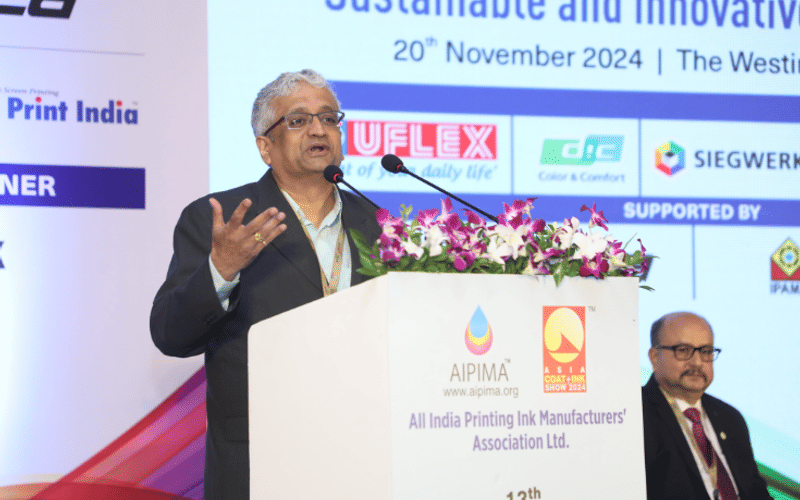SN Venkatraman talks about the future of packaging at AIPIMA conference
The packaging industry has witnessed transformative growth, with inks and coatings at the forefront of its evolution. From plain substrates to visually engaging solutions, the role of these elements is central to creating consumer-attractive designs. These thoughts were shared by SN Venkataraman, chief executive of ITC's Packaging and Printing Business during his keynote address at the AIPIMA International Conference.
26 Nov 2024 | By WhatPackaging? Team
The 13th International Conference was hosted by the All India Printing Ink Manufacturers Association on 20 November 2024 at The Westin Mumbai Garden City. This conference preceded the three-day Asia Coat + Ink Show.
SN Venkataraman, chief executive of ITC's Packaging and Printing Business, said, “Without ink, packaging remains a plain substrate. Inks transform white or brown surfaces into attractive products, enhancing brand appeal and driving market success.” This transformative power is evident in innovations such as metallic inks and scent-enabled packaging, which have set benchmarks for creativity and functionality.
Venkataraman noted that approximately 65% of the Indian packaging market is dominated by global companies, with domestic players holding the remaining 35%. “Despite this disparity,” he emphasised, “The industry is at an opportune moment for collaboration and innovation, with exports to Asian markets and increasing investments from multinational firms underscoring India’s growth potential. He further highlighted that India ranks seventh or eighth in the global pigments market, with ambitions to scale and compete with leaders like Germany and Japan.
The industry, however, faces mounting cost pressures due to fluctuating raw material prices and regulatory demands, Venkatraman noted.
Sustainability has become a defining theme, with Extended Producer Responsibility regulations driving change. Venkataraman pointed out the challenges of recycling flexible packaging, particularly in separating inks that act as contaminants. “Ink formulations capable of aiding in material separation at recovery facilities could revolutionise recycling practices. This approach could facilitate the efficient sorting and processing of materials like PET and BOPP, aligning with the government’s target of achieving 50% recycling rates by 2028.”
The transition from plastics to paper-based solutions is another key area of focus. “While paper-based packaging offers opportunities to reduce plastic use, challenges remain in maintaining seal strength and product safety,” said Venkataraman. He emphasised that collaboration across the supply chain, from substrate producers to brand owners, is essential for developing a new ecosystem that supports sustainable packaging.
Technology is also reshaping the landscape. Venkataraman pointed to the growing adoption of LED curing as an alternative to UV technologies, which are less suited for flexible packaging. He stressed the need for these innovations to be made cost-competitive in the Indian market. “The rise of eCommerce and quick-commerce trends has heightened the demand for customised and elder-friendly packaging solutions, further driving innovation.”
Premiumisation continues to be a key trend, with metallic inks and high-lustre finishes symbolising luxury and value. Venkataraman said, “There are challenges in replicating the gloss of foils with inks but the ink industry should look at how to advance foil lookalike technologies.” He also drew attention to proprietary coatings developed by ITC, which enhance product offerings and have the potential for broader market applications.
India’s packaging industry, supported by a population of 1.4-billion, has immense growth potential. However, Venkataraman cautioned that the sector must address talent shortages and align its strategies with regulatory requirements. “The paradox is: the Indian print professionals are in demand globally while the domestic industry faces skill shortages.”
Venkataraman alluded to the Chennai-based Murugappa Group, which has finalised an agreement to acquire Hubergroup, a German specialty chemicals firm. He said the consortium of Mavco and Avenue Capital signed an agreement to buy the printing and packaging ink specialist firm for USD 310-million. This, he said, highlights global aspiration from an India-based group. And is a sign of things to come.
Reflecting on the future, Venkataraman outlined key challenges, including ensuring food safety with low migration inks, improving LED curing technologies, and enhancing solvent recovery processes.
Venkatraman concluded by affirming that collaboration, innovation, and sustainability will define the industry’s trajectory. “The success of recycling and sustainability efforts will depend largely on the innovations from ink manufacturers. This is an opportunity for the industry to lead and create a sustainable future.”


